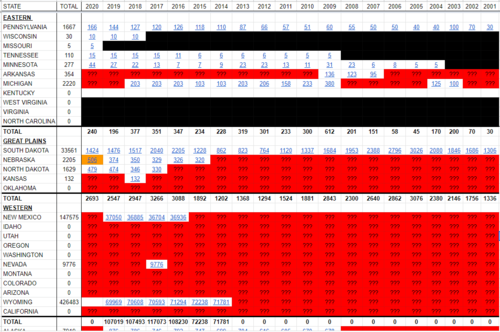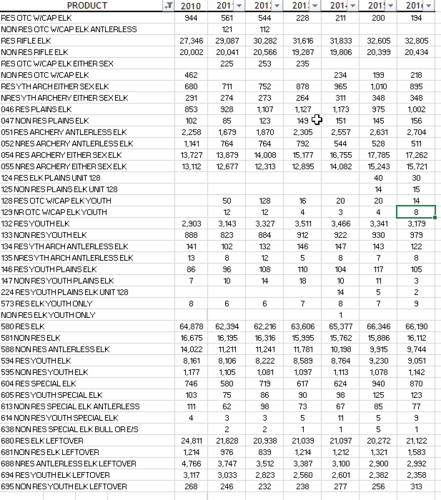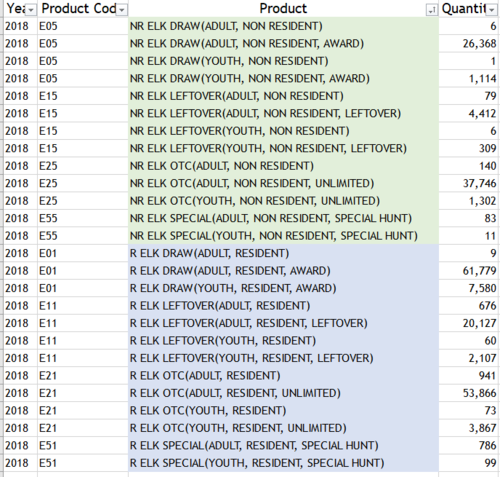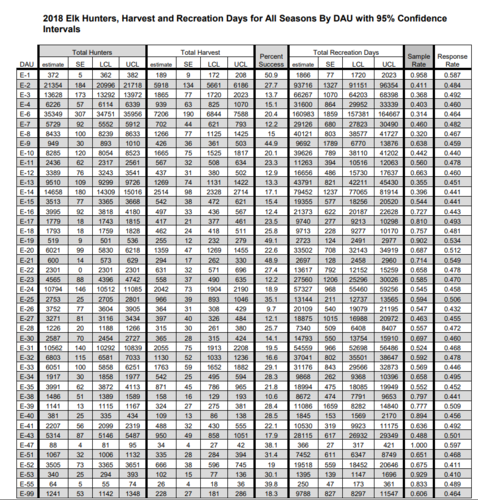seeth07
Well-known member
There is a recent forum post with a genuine question about the future of elk hunting. (found here: https://www.hunttalk.com/threads/future-of-elk-hunting-in-the-west-on-public-land.300258/)
As I read and participated in that discussion, one of the things that I wanted to know was whether or not actual hunting opportunities are on the increase or decrease. There is a lot of talk about how we are in the "glory days" of elk hunting. At the same time you hear lots of chatter stating that Elk hunting in the West is drastically trending upward. The second statement is pretty easy to prove just by looking at the amount of applicants in the various western big game states. There is no doubt that the interest in big game hunting is soaring as tags are getting harder to draw and OTC units disappear. So the question I have then is: Are we really in the glory days of elk hunting?
To start answering that question, a person has to define the meaning of "glory". I think for most hunters they would define it simply by volume of elk on the landscape and volume of chances to hunt them. Sure some may add that tagging big monster "trophies" is really what defines it but I would like to feel that the majority are more concerned about spending time chasing and harvesting animals for the experience and freezer.
So from my assumption that "glory days" of elk hunting is mostly about opportunity, I'm setting out on a journey to fully investigate how this has changed (or perhaps not changed) over the last 20 years. I'm collecting data from all the various state agencies from 2001 until this current 2020 season. What I'm looking for is the actual amount of licenses that were sold and using that for comparison of "hunting opportunity" over the last two decades. I've got a good start on it and I'll share right now where I'm at. The reason for sharing and jumping the gun on this forum post is because I actually could use some help. Some states I'm really struggling at finding correct and accurate information. Most eastern states were pretty easy (except for the fact of determining whether or not that 1 RMEF auction/raffle tag was including in the report) just simply due to the low volume of issued tags. Western states are much more difficult as not all of them seem to report actual license sales that are easy to find. If anyone has links or direction, I would greatly appreciate it!
When I'm all done, I'm going to write a full summary along with some key observations that I find from this little research project. Some will be obvious (like how eastern state elk hunting is on a very steady incline) and I'm sure some won't (like how Wyoming mountains and plains are actually getting less crowded by elk hunters each year). I also want to take this one step further and look at actual total elk harvests as well. I can already see the argument "yeah well so what if opportunity is increasing. That's just because the states want to make more money by selling more licenses. There are less elk being harvested each year so that is more important to look at".

As I read and participated in that discussion, one of the things that I wanted to know was whether or not actual hunting opportunities are on the increase or decrease. There is a lot of talk about how we are in the "glory days" of elk hunting. At the same time you hear lots of chatter stating that Elk hunting in the West is drastically trending upward. The second statement is pretty easy to prove just by looking at the amount of applicants in the various western big game states. There is no doubt that the interest in big game hunting is soaring as tags are getting harder to draw and OTC units disappear. So the question I have then is: Are we really in the glory days of elk hunting?
To start answering that question, a person has to define the meaning of "glory". I think for most hunters they would define it simply by volume of elk on the landscape and volume of chances to hunt them. Sure some may add that tagging big monster "trophies" is really what defines it but I would like to feel that the majority are more concerned about spending time chasing and harvesting animals for the experience and freezer.
So from my assumption that "glory days" of elk hunting is mostly about opportunity, I'm setting out on a journey to fully investigate how this has changed (or perhaps not changed) over the last 20 years. I'm collecting data from all the various state agencies from 2001 until this current 2020 season. What I'm looking for is the actual amount of licenses that were sold and using that for comparison of "hunting opportunity" over the last two decades. I've got a good start on it and I'll share right now where I'm at. The reason for sharing and jumping the gun on this forum post is because I actually could use some help. Some states I'm really struggling at finding correct and accurate information. Most eastern states were pretty easy (except for the fact of determining whether or not that 1 RMEF auction/raffle tag was including in the report) just simply due to the low volume of issued tags. Western states are much more difficult as not all of them seem to report actual license sales that are easy to find. If anyone has links or direction, I would greatly appreciate it!
When I'm all done, I'm going to write a full summary along with some key observations that I find from this little research project. Some will be obvious (like how eastern state elk hunting is on a very steady incline) and I'm sure some won't (like how Wyoming mountains and plains are actually getting less crowded by elk hunters each year). I also want to take this one step further and look at actual total elk harvests as well. I can already see the argument "yeah well so what if opportunity is increasing. That's just because the states want to make more money by selling more licenses. There are less elk being harvested each year so that is more important to look at".









